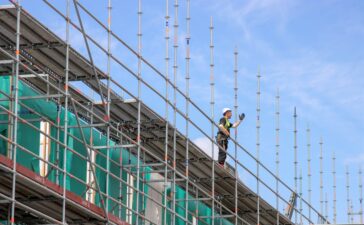Building your first home involves several key considerations to ensure a successful and satisfying outcome. Firstly, selecting the right location is crucial, focusing on factors such as convenience, safety, and future resale value. Secondly, the architectural design and layout should maximize space efficiency, incorporate natural light, and plan for future expansions. Thirdly, choosing quality construction materials is essential for durability and energy efficiency, with options like brick siding, metal roofing, and insulated windows being recommended. Finally, setting a realistic budget.
When it comes to building your first home, there are a lot of things to consider. From choosing the right location to deciding on the style of your home, the process can be overwhelming. However, by focusing on a few key factors, you can ensure that your first home is both functional and beautiful.
The first thing to consider when building your first home is the location. You want to choose a location that is convenient to your work, schools, and other amenities. You also want to make sure that the location is safe and has a low crime rate. Additionally, you should consider the resale value of the location, in case you decide to sell your home in the future.
Another important factor to consider when building your first home is the style of the home. There are many different styles to choose from, including traditional, modern, and contemporary. You should choose a style that reflects your personal taste and fits in with the overall look of the neighborhood. Additionally, you should consider the size of the home, as well as the number of bedrooms and bathrooms that you need.
Location and Lot Selection
When building your first home, choosing the right location and lot is crucial. Here are three factors to consider when evaluating potential locations:
Evaluating the Neighborhood
Start by researching the neighborhood where you plan to build. Look for information on crime rates, school quality, property values, and proximity to amenities like parks, shopping centers, and public transportation. You may also want to visit the neighborhood at different times of day to get a sense of the noise level and traffic patterns.
Understanding Zoning Laws
Before you buy a lot, make sure you understand the local zoning laws. Zoning laws regulate what types of buildings can be constructed in a given area. You’ll need to know what the zoning laws are for your desired location to ensure that your building plans are compliant.
Assessing the Land Topography
The topography of the land can affect the design and construction of your home. Sloping or uneven land may require additional excavation or foundation work, which can increase costs. You’ll also want to consider factors like soil quality, drainage, and the presence of trees or other natural features that may impact your building plans.
By carefully evaluating the neighborhood, understanding zoning laws, and assessing the land topography, you can choose a location and lot that meets your needs and budget.
Architectural Design and Layout
When building your first home, architectural design and layout are crucial factors to consider. Not only do they determine the overall look and feel of your home, but they also impact its functionality and livability. Here are three important aspects to keep in mind when designing your home:
Maximizing Space Efficiency
One of the primary goals of any home design is to maximize space efficiency. This means creating a layout that utilizes every square foot of your home in a practical and functional way. To achieve this, consider the following:
- Open floor plans: Open floor plans are great for maximizing space and creating a sense of flow throughout your home.
- Built-in storage: Built-in storage solutions, such as closets and cabinets, can help you make the most of your space while keeping your home clutter-free.
- Multi-purpose rooms: Rooms that serve multiple functions, such as a guest bedroom that also doubles as a home office, can help you maximize your space without sacrificing comfort.
Incorporating Natural Light
Natural light is a key element in any home design. It not only enhances the aesthetic appeal of your home, but it also has a positive impact on your mood and well-being. When designing your home, consider the following:
- Window placement: Place windows strategically to maximize natural light and take advantage of views.
- Skylights: Skylights are a great way to bring natural light into rooms that might not have access to windows.
- Light-colored walls: Light-colored walls reflect natural light, making your home feel brighter and more spacious.
Planning for Future Expansion
When designing your home, it’s important to plan for future expansion. Whether you’re thinking about starting a family or simply want more space, designing your home with expansion in mind can save you time and money down the line. Consider the following:
- Extra space: Plan for extra space that can be easily converted into additional rooms or living areas.
- Structural considerations: Work with your architect to ensure that your home’s structure can accommodate future expansion.
- Zoning regulations: Be aware of zoning regulations in your area to ensure that any future expansion plans are feasible.
By keeping these aspects in mind when designing your home, you can create a space that is both functional and beautiful, and that will meet your needs for years to come.
Quality of Construction Materials
When building your first home, it’s important to choose quality construction materials that will provide durability and energy efficiency. Here are two key factors to consider:
Choosing Durable Building Materials
When selecting materials for your home, keep in mind that durability is key. You want materials that will stand up to the test of time and require minimal maintenance. Some durable options to consider include:
- Brick or stone siding: These materials are not only long-lasting, but they also provide excellent insulation and can help regulate indoor temperatures.
- Metal roofing: Metal roofs are durable and can last up to 50 years or more, making them a great investment for your home.
- Composite decking: Unlike traditional wood decking, composite decking is resistant to rot, fading, and warping, making it a low-maintenance option for your outdoor space.
Considering Energy-Efficient Options
In addition to durability, it’s important to consider energy efficiency when choosing construction materials. Energy-efficient materials can help reduce your energy bills and minimize your impact on the environment. Here are a few options to consider:
- Insulated windows: Insulated windows can help regulate indoor temperatures and reduce your heating and cooling costs.
- Energy-efficient appliances: When selecting appliances for your home, look for models that have earned the ENERGY STAR label, which indicates that they meet strict energy efficiency guidelines.
- Low-flow fixtures: Low-flow toilets, showerheads, and faucets can help conserve water and reduce your water bills.
By choosing durable and energy-efficient materials for your home, you can ensure that your investment will last for years to come while also minimizing your impact on the environment.
Budget and Financing
Setting a Realistic Budget
When building your first home, one of the most important things to consider is your budget. It’s important to set a realistic budget that takes into account all of the costs associated with building a new home. This includes the cost of the land, materials, labor, permits, and any unexpected expenses that may arise during the building process.
To set a realistic budget, you should start by doing some research and getting quotes from several different expert first home builders and contractors. This will give you a good idea of the average cost of building a home in your area. You should also consider factors such as the size and style of the home you want to build, as well as any additional features or upgrades you may want to include.
Once you have a good understanding of the costs involved, you can start to create a budget that works for you. It’s important to be realistic and to factor in some extra money for unexpected expenses. You should also consider your financing options and how much you can afford to borrow.
Exploring Financing Options
When it comes to financing your new home, there are several options to consider. One of the most common options is a traditional mortgage, which allows you to borrow money from a bank or other lender to pay for the cost of building your home. You will need to have a good credit score and a steady income to qualify for a mortgage.
Another option is a construction loan, which is specifically designed to help you finance the cost of building a new home. These loans typically have higher interest rates and shorter repayment terms than traditional mortgages, but they can be a good option if you don’t have a lot of equity in your current home.
Finally, you may be able to finance your new home through a government-backed program such as the FHA or VA loan programs. These programs offer lower down payments and more flexible credit requirements than traditional mortgages, making them a good option for first-time homebuyers.
No matter which financing option you choose, it’s important to work with a reputable lender who can help you navigate the process and find the best loan for your needs. With the right financing and a realistic budget, you can build the home of your dreams without breaking the bank.






